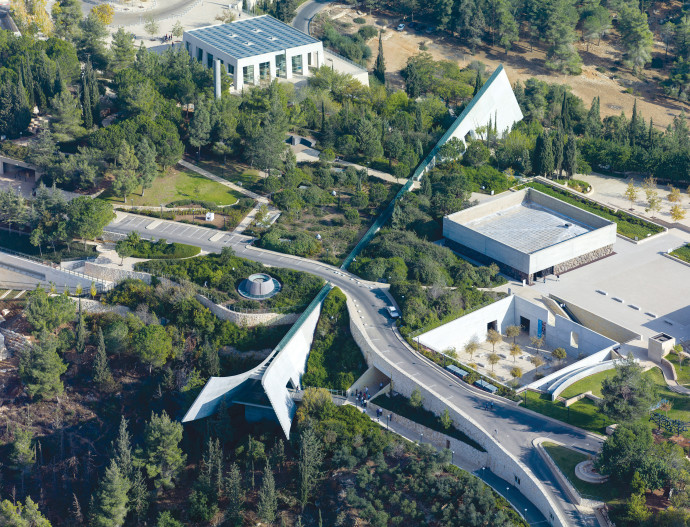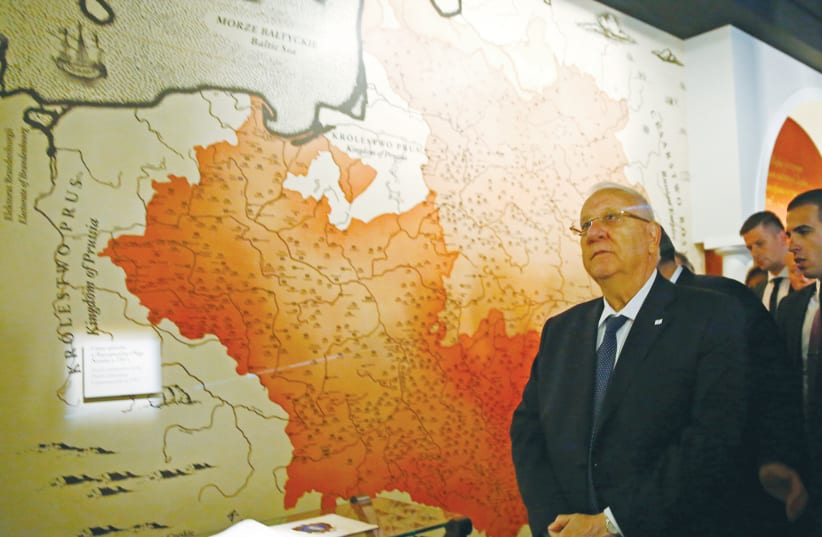On a recent visit to Yad Vashem, I noticed its stunning architecture and magnificent design. I entered downward into the triangular brutalist historical museum, without the possibility of escape, and came out the other side to the beautiful hills of Jerusalem.
There is the wagon car on the hill; the children’s memorial carved out of the rock consisting simply of names, candles and mirrors. Moshe Safdie, the other architects and designers involved, and the entire planning committee simply did a magnificent job.
There is one aspect of the design that is rarely mentioned, yet represents perhaps the key to successful Holocaust – and Jewish – education: as you enter main historical museum, the first thing you see is a huge triangular video display by artist Michal Rovner.
Choosing Rovner’s work to “set the tone” for the journey back in time and place was simply brilliant. Born in 1957 and now splitting her time between Israel and the US, Rovner is considered a leading successful Israeli artist in the world and her work “Makom 1” is a notably expensive work of art.
Her work has been exhibited dozens of times at many of the most prestigious art museums in the world, including the Louvre, the Metropolitan Museum of Art, MoMA (the Museum of Modern Art), the Whitney Museum of American Art and many others.


Artistically, her Yad Vashem display is impressive, to say the least. Entitled “Living Landscape,” Rovner’s work is a kaleidoscope of film archives showing the variety, depth, inter-connectedness and vitality of Jewish life in pre-War Europe.
It is simply stunning, and if there wasn’t so much else to see at Yad Vashem, one could spend much time just “taking in” the amazing – and sometimes surprising – images of a Lost World.
Even more importantly, though, her exhibit is a masterpiece in education. To understand the loss, indeed before we focus on it at all, it is crucial to get a sense of what was lost – the incredible, inspiring, fractious, wonderful Jewish life that existed until September 1939.
Without a Rovner-like introduction to the Holocaust, six million is just a number. Once “introduced” to pre-War Jewish Europe, we appreciate that six million individual Jewish lives – of all types – were destroyed; it wasn’t one unnamed mass of six million. The difference is huge.
This model (understand what was lost not just what they did to us) is used in more and more Jewish trips to Poland (which are now, once again, on hold due to tensions between the Israeli and Polish governments). Most groups visit old shuls, the Jewish Quarter in Krakow and hear stories of Jewish life.
Indeed, unlike their original itinerary, the March Of The Living (MOTL) trips to Poland have “broadened” their focus by spending time on Jewish life before the war, including often visiting the magnificent museum, “Polin: The Museum of the History of Polish Jews” which sits on what was once the Warsaw Ghetto.
The Polin Museum
THE GREATNESS of the Polin Museum (which opened to the public in 2013) is that it is – almost – completely focused on the thousand years of rich Jewish history in Poland before the War, not the years of destruction themselves.
It is important to learn about the destruction of Jewish life that is covered by many other well-visited sites in Poland, such as the extermination camp Auschwitz-Birkenau itself; to fully understand what was destroyed one needs a Rovner-like framing.
A similar question (what to focus on) can be found in the work of great French philosopher Jean-Paul Sartre. Even before World War II was over, following the liberation of Paris in 1944, Sartre wrote his Anti-Semite and Jew: An Exploration of the Etiology of Hate.
His damning analysis of the anti-Semite has stood the test of time. However, his analysis of the Jew has not: While familiar with some assimilated Jews, Sartre knew no “religious” or “traditional” Jews, knew nothing of traditional Jewish life, did no research on Judaism, and therefore (incredibly) concluded that, “the anti-Semite creates the Jew.”
This conclusion would no doubt surprise Abraham and Sarah, Moses and Miriam, and hundreds of millions of Jewish men and women throughout history who have led deeply enriching spiritual and communal lives grounded in Jewish learning and philosophy.
While well intentioned, Sartre’s analysis is both insulting and laughable. Insulting because Jewish identity is independent, beautiful and strong, regardless of the opinions of antisemites. As a rabbi once said, “what they do to us is part of our story, but only a small part.” Laughable because only a man as smart as Sartre would dare write a book about a subject about which he clearly knew so little.
Still, I wonder if we are, in our own way, making a similar mistake.
Discussions in the Jewish world
A huge percentage (perhaps a majority?) of the subjects discussed in the Jewish world (in the media, Jewish educational settings, and elsewhere) seem to be focused on antisemitism, BDS, Israel’s security challenges and the Holocaust. All of these are very important, of course, but what about Jewish identity itself? What about Jewish life? A Jewish school I recently worked with devotes more time to Holocaust studies than actual classes about Judaism.
I teach and love Holocaust studies… but really? Aren’t things a little out of whack?
Yad Vashem understood that even when discussing the Holocaust, we can’t just talk about what they did to us. Certainly, antisemitism can’t be the main theme of Jewish identity.
Sartre was wrong, wasn’t he?
The writer is the author of Why Be Jewish? and the cofounder of Mosaica Press.
